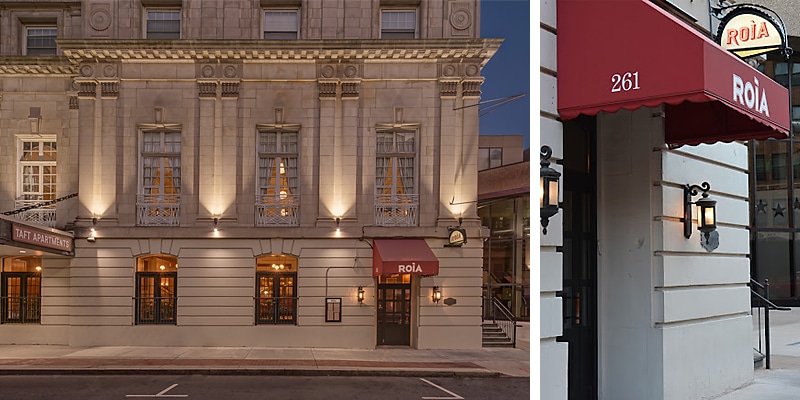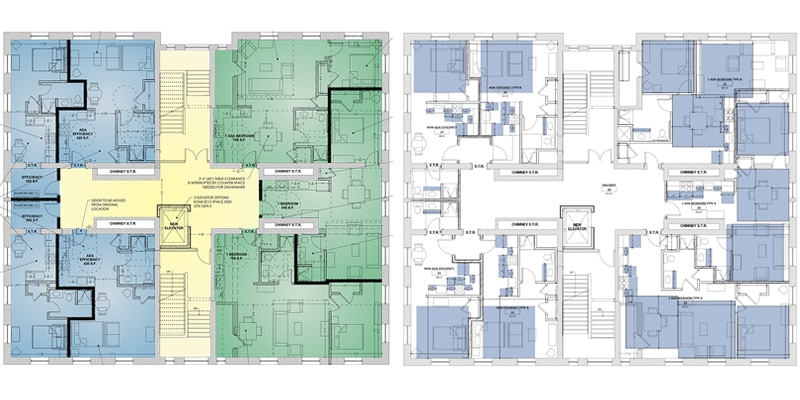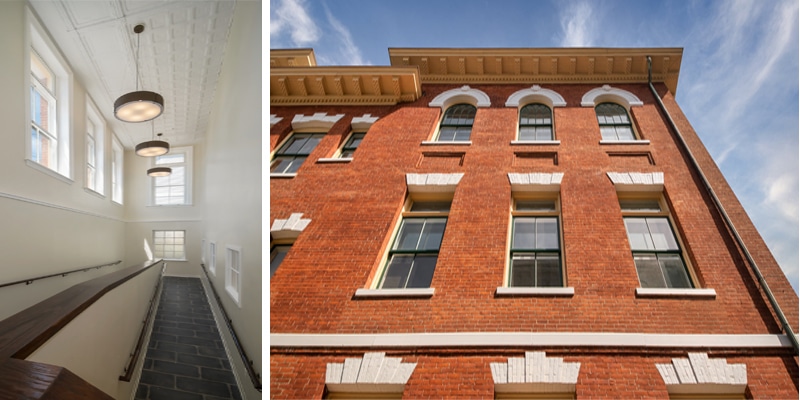If you own a historic building and are considering improving it, you should keep in mind that there are funds available for the renovation, restoration, or rehabilitation of these types of structures. The Secretary of the Interior maintains separate “standards” documents for the different types of work performed on historic properties, but our team can help you understand the standards and determine the best funding types for your project.
It is also important to note that when working with funding agencies, you must tailor your project to the requirements of the funding type. And it is important to have your funding established early in the project since architects and engineers will design to those requirements or guidelines.
Below are examples of funding sources in Connecticut at the municipal, state, and federal levels.
Municipal-Level Funding: Façade Improvement Grant Program
This program is designed to support façade (a building’s street-facing elevation) improvements to commercial and mixed-use properties that benefit both the businesses occupying those buildings and the community as a whole. Approved applicants can receive a reimbursement grant of up to 50% of the total pre-tax façade construction cost, up to a maximum of $30,000 per façade.
Some of the design considerations under this program include:
- The impact on neighboring buildings
- The impact on the overall “fabric” of the neighborhood
- Signage, lighting, and awnings are included
- All building materials must be documented and presented

Roìa Restaurant worked with the City of New Haven’s Façade Improvement Program director to help defray costs of exterior renovations, signage and awnings.
Our project at Roìa Restaurant in New Haven, CT, utilized this program. The restaurant occupies what was originally the dining room of the Taft Hotel, which was built in 1912. The project included interior and exterior renovations.
Our client worked with the City of New Haven to obtain funds through their Façade Improvement Grant Program. The funding is a matching contribution toward exterior improvements only. For this project, it included railings, entry doors, windows, lighting, awning, and signage. The drawings we prepared were elevations depicting the scope of work and color renderings that showed signage, awnings, and paint colors.
State-Level Funding: Connecticut Housing Finance Authority (CHFA)
The intent of funding from CHFA is to facilitate the design and construction of multifamily housing with as much quality, durability, and environmental sustainability as the marketplace, resources, and need will allow. It covers funding for multifamily housing, whether new construction, renovation, or historic rehabilitation.
Design considerations with CHFA funding include site elements like common areas, and specific spatial requirements for unit elements—layouts for kitchen, bathrooms, dining areas, living areas, and bedrooms.

Saint Mary Place: The adaptive reuse of the former elementary school to affordable apartments was partially funded by the CT Housing Finance Authority
Our Saint Mary Place project used CHFA funding. It involved the historic rehabilitation or adaptive reuse of an elementary school to serve as affordable housing. This school, built in 1898 by the Saint Mary Star of the Sea Church, had three floors of classrooms and a lower level used for bathrooms, storage, and indoor play.
CHFA being one of the major funders, we converted the classroom floors to apartments that fit the CHFA guidelines and adapted the lower-level spaces for amenities like a common room, laundry facilities, training rooms, and offices.
After we explored several options for unit types using CHFA guidelines for room sizes, the owner decided on a mix of one-bedroom and efficiency (studio) units. The guidelines include specific dimensions for kitchen appliances and counter sizes. Those same guidelines and the applicable building code determined the configuration of ADA-compliant bathroom layouts. Our task also included keeping the demolition of existing walls to a minimum and reusing as many historic architectural elements as possible.
National-Level Funding: The Federal Historic Preservation Tax Incentives Program (administered through the State Historic Preservation Office)
The purpose of this program is to fund the preservation or rehabilitation of a historic building for modern use while preserving its historic character. It covers construction costs for the repair, reconfiguration, or replacement of historic elements only.
Design considerations with this program include:
- Construction-document-level details required for historic elements, both exterior and interior
- Building materials must match/complement historic ones
- State Historic Preservation Offices information and guidance is required

Saint Mary Place: The Federal Historic Preservation Tax Incentives Program contributed to the restoration and renovation of historic elements on the interior and exterior of the building.
Our Saint Mary Place project, described above, also included funding from the Federal Historic Preservation Tax Incentives Program.
Our Unique Approach to Helping Clients Leverage Funding Sources for Historic Renovations
Utilizing funding sources for work on historic buildings requires early exploration of the architectural implications to the intended use and design of the project. When multiple sources are used, we have found that requirements or guidelines can have conflicting goals.
For instance, space requirements in the CHFA guidelines, written for new construction, do not always work well in existing historic structures. Also, guidelines from the Secretary of the Interior for historic building projects funded with preservation tax incentives require that building faces that are visible to the public remain uncluttered by mechanical, electrical, or plumbing systems—a requirement that may be hard to meet.
When encountering requirements that are difficult or impossible to achieve, we find that early discovery and discussion of possible conflicts with the funding sources are key to identifying solutions that will be satisfactory to all parties. We strive for pre-submission discussions with each funder, ideally at the same table (or on the same Zoom call), to resolve conflicting requirements.
Similarly, if unforeseen conditions are discovered during construction, a continuing dialogue with funders enables quick decision-making, which is key to keeping a project on budget and on schedule.
Learn More About Patriquin Architects
Our services cover new construction, historic buildings, alteration and renovation, and site analysis and feasibility studies. See how clients have used our services in past projects in our portfolio. And if you have questions about a project or our services, please contact us at your convenience.
